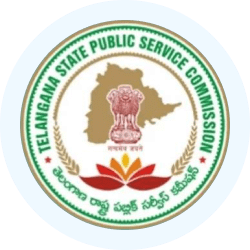TSPSC (Telangana) Exam > TSPSC (Telangana) Notes > Telangana State PSC (TSPSC): Preparation Course > Painting of Telangana
Painting of Telangana | Telangana State PSC (TSPSC): Preparation Course - TSPSC (Telangana) PDF Download
Artistic Heritage of Telangana
- Historical Background: Telangana boasts a rich artistic legacy dating back to the eras of Chalukyas, Kakatiya, and Vijaynagara rulers. The region witnessed the influence of Mughal paintings during the Mughal era, which continued to thrive through the Nizams of Hyderabad. However, rural paintings in Telangana and Andhra Pradesh experienced a decline from the medieval period onwards.
- Diversity of Art Forms: Various NGOs and self-help organizations, both in the private and public sectors, play a pivotal role in promoting the diverse range of Telangana paintings. These include Nirmal paintings, representing the unique rural art of Telangana, along with Deccani Painting, Vijayanagar Paintings, Cheriyal Scroll Paintings, and Mughal Paintings. These art forms serve as a source of pride for the state, attracting visitors from far and wide to witness them in Telangana's museums.
Types of Paintings
Cheriyal Scroll Paintings
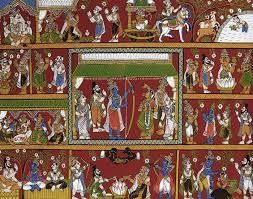
- Cheriyal Scroll Painting is a distinct form of art, originating from Telangana and primarily produced in Hyderabad today. It is an evolved version of Nakashi art, renowned for its incorporation of local motifs and rich storytelling. These paintings are crafted in a narrative format akin to film rolls or comic strips, portraying tales from Indian mythology, Puranas, and Epics.
- With a history deeply rooted in local traditions, Cheriyal paintings are a unique creation of Telangana, reflecting the region's cultural heritage. The artists, known as Nakashis, play a pivotal role in preserving and propagating this art form, which holds significant cultural importance in Telangana.
- Originally associated with Cheriyal village, these paintings were referred to as Cheriyal scrolls. They initially depicted the adventures of local folk heroes, serving as a form of entertainment and storytelling for the community. Cheriyal scroll paintings were traditionally presented alongside music and dance performances by the Kaki Padagollu, a community of storytellers and balladeers.
- Typically, Cheriyal scrolls are wide, ranging approximately three feet in width and 40 to 45 feet in length, depending on the story being depicted. The narrative unfolds through a series of horizontal panels separated by a floral border, with the scroll held or suspended for viewing. While traditional scrolls were extensive, modern adaptations involve creating smaller versions focusing on single episodes or specific characters. These smaller scrolls are easily framed and serve as decorative pieces in contemporary homes.
- The process of creating Cheriyal paintings involves a meticulous procedure. Khadi cotton, starch, white mud, and a paste of tamarind seeds and gum water are used to craft the canvas. Once the canvas is ready, artists directly outline the images using brushes. These outlines are meticulously defined, displaying the quality and skill of Cheriyal craftsmen. Presently, the tradition of Cheriyal painting is carried on by a select few families, with only a handful of artists remaining who continue to utilize this unique technique.
- A recent innovation in Cheriyal painting is the creation of single pictures instead of continuous scrolls, intended for wall decorations. Cheriyal paintings are easily identifiable by their distinctive characteristics: vibrant hues, primarily using primary colors, with red often dominating the background. These paintings showcase the boundless imagination of local artisans, incorporating a strong local idiom into the iconography of major deities such as Vishnu and Shiva.
- The subjects depicted in Cheriyal scroll paintings draw inspiration from mythological, ancient literary, and folk traditions. Themes include Krishna Leela, Mahabharata, Ramayana, Shiva Puranam, Markandey Puranam, as well as ballads and folk stories of various communities like Gauda, Madiga, and others. The narratives often portray scenes from rural life, depicting women engaged in kitchen chores, men working in fields, festive settings, and other aspects of Telangana's culture.
- Cheriyal Painting's popularity stems from its unique rural essence, exuding an aura of exclusivity and charm. It stands as a source of pride for Telangana, showcasing the region's rich heritage of rare and distinctive art forms. Recognizing its cultural significance, Cheriyal scroll painting was granted Intellectual Property Rights Protection, commonly known as the Geographical Indication (GI) tag, in 2007. This art form garners academic interest from painters worldwide, who study its intricacies with meticulous attention to detail. Efforts are underway to preserve this rich tradition for future generations by actively promoting the practice of Cheriyal Painting.
Question for Painting of TelanganaTry yourself: Which art form originated from Telangana and is known for its incorporation of local motifs and rich storytelling?View Solution
Nirmal Paintings of Telangana
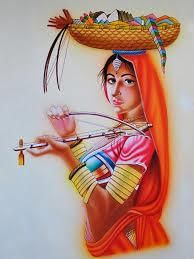
- Nirmal town, situated in the Nirmal district of Telangana, is renowned for its art and craft traditions.
- The craftsmen in Nirmal, known as 'Naqash,' have been practicing the art of Nirmal paintings since the 14th century.
- Nirmal Paintings primarily depict scenes from Hindu epics like Ramayana and Mahabharata, influenced by Indian Schools of Art such as Kangra and Ajanta.
- The art form has evolved over time, incorporating elements from Mughal miniatures and traditional Kakatiya dynasty designs.
- The Nizam of Hyderabad played a crucial role in promoting Nirmal paintings after being impressed by the artisans' skills.
- Lady Hyder, in the 1950s, brought Nirmal artisans to Hyderabad to further develop and promote this craft.
- Nirmal paintings are known for their intricate designs, vibrant colors, and use of organic materials like herbs, vegetable dyes, and minerals.
- The paintings cover a wide range of subjects, from nature scenes to cultural motifs, capturing the viewer's attention with their beauty.
- The process of creating Nirmal paintings involves meticulous steps like preparing the wooden plank, applying luppam paint, and painting the design.
- Nirmal craftsmen also produce lacquered furniture, toys, screens, trays, and other decorative items with fine detailing and craftsmanship.
- The art form has gained international recognition, with Nirmal paintings being exported to countries like Australia, USA, and UK.
Artistic Evolution and Influences
- Nirmal paintings have been influenced by various art styles, including Kangra, Ajanta, and Mughal miniatures.
- The art form has evolved from traditional epics to encompass a broader range of motifs and styles to meet modern demands.
Artisan Techniques and Processes
- The creation of Nirmal paintings involves a meticulous process, starting from preparing the wooden base to applying organic colors.
- Artisans use techniques like applying luppam paint, painting motifs, and finishing with a protective coating to ensure longevity.
Batik Paintings of Telangana
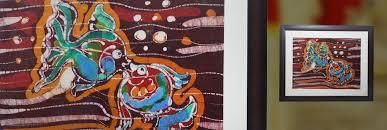
- Batik painting is an ancient and exquisitely beautiful art form that involves intricate figures and patterns drawn on pieces of fabric. Originating in Indonesia, the term "batik" originally referred to the dots found on clothes. This art technique, which utilizes a wax-resist dye method, has a history spanning over one thousand years. While batik is widely practiced in regions like Java (Indonesia), India also boasts a rich tradition in batik painting, producing stunning works of art from various parts of the country.
- Batik artists primarily use dyes as their medium, requiring a keen sense of color and pattern. To create captivating batik paintings, artists layer wax and dye onto the fabric, emphasizing the use of vibrant colors. The batik process involves coating part of the fabric with wax before dyeing it. The waxed areas preserve their original color, resulting in striking contrasts between dyed and non-dyed sections when the wax is removed.
- This intricate art form follows a three-stage process: waxing, dyeing, and de-waxing. Additional steps include preparing the fabric and designs, stretching the cloth on a frame, applying wax to areas not intended for dyeing, preparing the dye, immersing the cloth in the dye, and boiling the fabric to remove the wax. This process is repeated multiple times until the desired batik design or fabric is achieved.
- The distinctive designs found in batik are a result of the fine cracks that form in the wax, allowing small amounts of dye to seep in. Batik waxing is a crucial step in the batik printing process, contributing to the characteristic appearance of batik fabrics. Common fabrics used for batik prints include poplin, voiles, cambric, and pure silk. Natural colors derived from tree barks, flowers, leaves, and minerals are often utilized in batik art.
- Batik can be created through various methods, such as screen printing, splash method, and hand painting using a Kalamkari pen. Each piece of batik painting possesses a unique quality due to the endless possibilities offered by combinations of dye colors, wax effects, and fabric types. Precision and concentration are essential in the batik painting technique.
- Batik wall hangings are highly favored by art enthusiasts, offering a distinct aesthetic appeal. Traditionally, batik paintings often feature dark brown, indigo, and white colors, symbolizing the three major Hindu Gods: Brahma, Vishnu, and Shiva. Batik-printed saris, kurtis, and wrappers are popular choices among fashion enthusiasts, with Indian cotton and dyes being particularly renowned for their use in batik art.
Deccani Paintings of Telangana
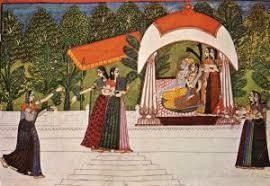
- Deccani paintings originated in the Deccan region of South Central India, ruled by Hindu kings at the advent of the first Muslim sultanates in Delhi.
- This style of miniature painting thrived from the late 16th century among the Deccani sultanates in peninsular India.
- Deccani paintings exhibit a unique blend of original and foreign art forms, with influences from Vijayanagar wall paintings and Persian art.
- These paintings feature elongated figures, floral-sprigged backgrounds, high horizons, and rich, luminous colors including gold and white.
Question for Painting of TelanganaTry yourself: What is the main subject matter depicted in Nirmal paintings?View Solution
Mughal Painting
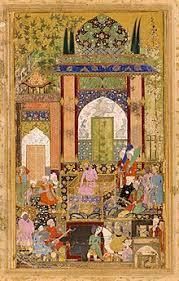
- Mughal painting, originating in Delhi, spread throughout India due to royal patronage and popularity.
- Under Mughal emperors, this art form flourished but declined when royal interest waned in the later medieval era.
- Subjects of Mughal paintings were mainly secular, encompassing historical illustrations, portraits, natural life studies, and genre scenes.
- The Mughal Painting school began during Emperor Humayun's reign and gained prominence in South Indian states such as Hoysala, Vijayanagara, and Chalukyas.
Vijaynagar Paintings of Telangana
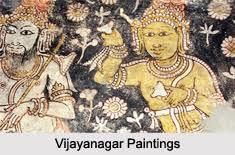
- Vijaynagar Paintings became popular during the medieval period under the rule of Vijayanagara in Telangana. These artworks marked a significant resurgence of Hindu art and culture in South India.
- Wall paintings experienced a revival during the Vijayanagar era, with notable examples found at the Virabhadra temple in Lepakshi. The paintings at Lepakshi are characterized by ornate decorations.
- Characteristics of Vijayanagar paintings include side-view human faces, figures standing with a slight slant and both feet pointing in the same direction.
- Some paintings depict scenes such as the wedding of Draupadi and Kiratarjunya, as well as portrayals of Viruppanna and Viranna with their sons and guards.
- The depicted figures wear long, white garments with a printed cloth around their waists. These paintings were considered more valuable than diamonds during that time.
Notable Features of Vijaynagar Paintings
- Intricate Decorations: Vijayanagar paintings are known for their elaborate and detailed decorations, adding richness to the visual narratives.
- Symbolism and Mythology: Many paintings carry symbolic meanings and depict scenes from Hindu mythology, offering viewers a glimpse into the cultural and religious beliefs of the era.
- Artistic Techniques: Artists employed specific techniques such as side-profile portraits and unique postures to convey emotions and narratives effectively.
- Historical Significance: These paintings not only served as artistic expressions but also played a crucial role in preserving historical events and cultural practices of the Vijayanagar period.
Question for Painting of TelanganaTry yourself: What was the subject matter of Mughal paintings?View Solution
The document Painting of Telangana | Telangana State PSC (TSPSC): Preparation Course - TSPSC (Telangana) is a part of the TSPSC (Telangana) Course Telangana State PSC (TSPSC): Preparation Course.
All you need of TSPSC (Telangana) at this link: TSPSC (Telangana)
|
80 docs|74 tests
|
FAQs on Painting of Telangana - Telangana State PSC (TSPSC): Preparation Course - TSPSC (Telangana)
| 1. What are Nirmal Paintings of Telangana? |  |
Ans. Nirmal Paintings of Telangana are a traditional art form that originated in the town of Nirmal in Telangana. These paintings are known for their intricate designs and vibrant colors, often depicting scenes from nature or mythology.
| 2. What is the significance of Batik Paintings in Telangana? |  |
Ans. Batik Paintings of Telangana are a popular art form that involves using wax and dyes to create intricate designs on fabric. These paintings are known for their unique patterns and are often used to create clothing and home decor items.
| 3. How do Deccani Paintings of Telangana differ from other art forms? |  |
Ans. Deccani Paintings of Telangana are a style of painting that developed in the Deccan region, including Telangana. These paintings are known for their blend of Persian and Indian influences, often featuring intricate details and vibrant colors.
| 4. What is the history behind Mughal Paintings in Telangana? |  |
Ans. Mughal Paintings of Telangana are a style of painting that was popular during the Mughal Empire. These paintings often depict scenes from the royal court and are known for their attention to detail and use of rich colors.
| 5. How can one learn more about the Painting of Telangana for the TSPSC exam? |  |
Ans. To learn more about the Painting of Telangana for the TSPSC exam, candidates can refer to study materials provided by the Telangana State Public Service Commission (TSPSC) or attend coaching classes that focus on art and culture of the region. Additionally, practicing previous years' question papers can help candidates familiarize themselves with the type of questions asked in the exam.
Related Searches




